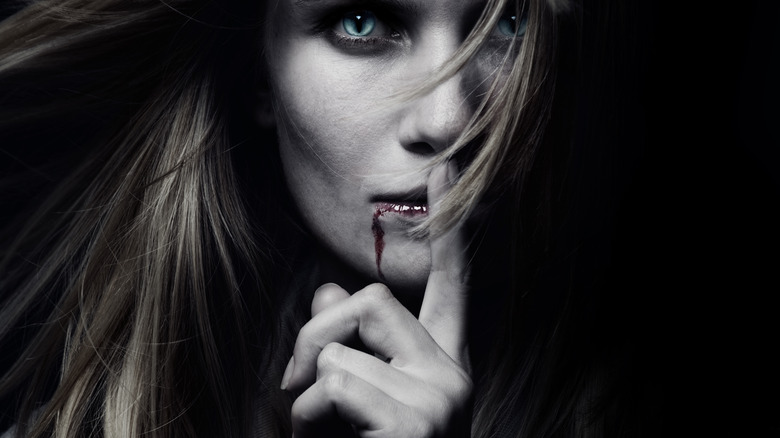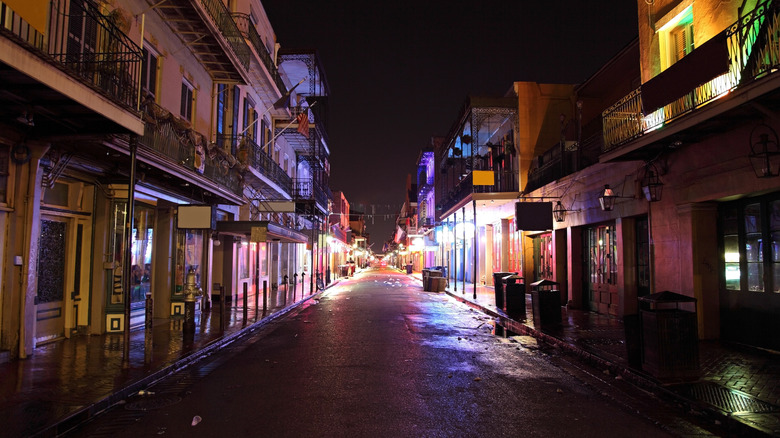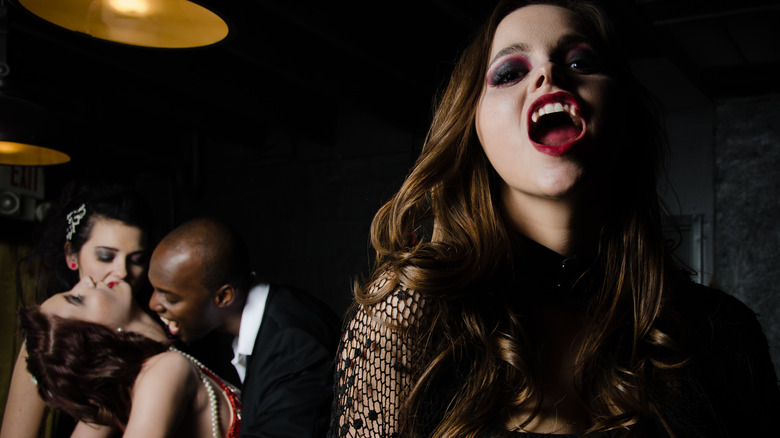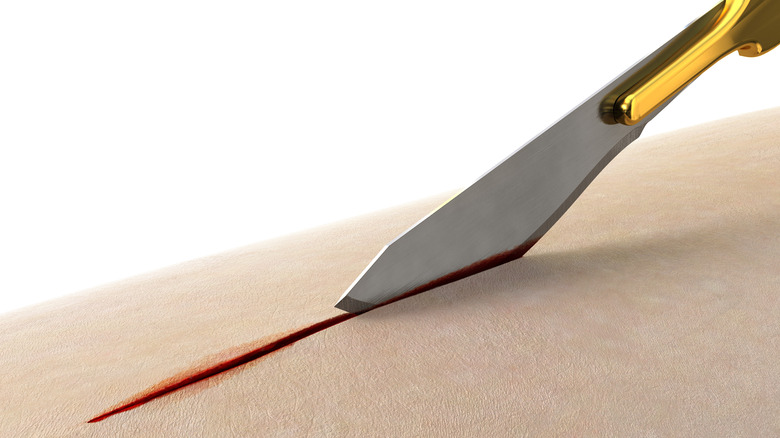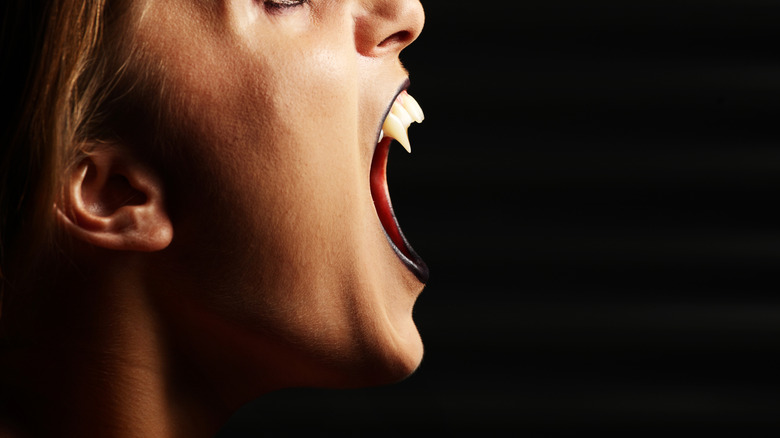An Inside Look At The Vampire Communities Of New Orleans
Vampires: Simple stock monsters for scare and thrill purposes in literature and cinema? Or, a nuanced take on the allure of repressed sexuality and society's disillusioned coming to pierce you in your sleep and convert you to their unholy, ultra-Goth cause? It's true that our modern take on vampires — inspired almost wholly by Bram Stoker's 1897 novel "Dracula" — has evolved into something closer to suave aristocrats and nightclub goers exuding very unsubtle sex appeal than any kind of terrifying undead creature of the night. Vampires, as creatures consigned to lurk out of the daylit view of others, have transformed into icons for the oppressed and culturally sidelined. Or, they've transformed into those sparkly folks from "Twilight."
So when we talk about "vampire communities in New Orleans," we don't mean that some daring, cross-and-holy-water wielding Van Helsing dude infiltrated an ancient order of immortal, blood-sucking, seriously iron deficiency, fanged undead hanging out in crypts. We mean people with day jobs like graphic designer, jeweler, and "expert in antique furnishings" Merticus, per CNN. New Orleans vampire Maven Lore says he and his kin "all just wanna get along and be loved" — and he's the "king" of the Vampire Court of New Orleans, a vampiric collective with a Facebook page featuring a censored 2019 picture of a "naked pool party" in honor of its "High Priestess' name day." "Say what?" many will respond. But don't worry — when getting to the bottom of this topic we promise to only sink fang-deep.
Fangs, coffee, and Goth karaoke night
It'd be very easy to take one glance at the vampires of New Orleans, scoff, and dismiss it all as a delusional LARP. But, self-described "vampire" communities are far less fringe than the reader might imagine. Hindustan Times reports on such groups across the world "from the U.S. and U.K. to Russia and South Africa." Besides New Orleans, the U.S. has prominent enclaves in California, Buffalo, Atlanta, and likely plenty of other places. In fact, from 2006 to 2009 Suscitatio Enterprises, LLC conducted an independent "Vampirism and Energy Work Research Study" that surveyed over 670,000 people, per the Atlanta Vampire Alliance, an organization that CNN says was co-founded by New Orleans vampire Merticus. The Washington Post reports that they uncovered about 5,000 vampires, a number that's doubtlessly grown since then.
Vampirism didn't start with that survey, though. Hindustan Times reported, New York City-based "Father Sebastiaan" discusses life as a "fangsmith" forging prosthetic fangs since 1995 and hosting Endless Night Vampire Balls for creatures of the night. Along those lines, businesses like Kaos Kustom Fangs offer custom-made, "high-grade dental acrylics" to would-be vampires. They also offer a line of organic, fair-trade tea via the Vampyre Tea Company. Similarly, Florida-dwelling vampire "Crimson" hoped in 2009 to open a Tampa-based coffee shop featuring "a Gothic coffee line," per Deseret News. She worked for a punk bar that hosted a Goth karaoke night every Monday. All in all, such descriptions portray vampire communities as similar to other underground subcultures.
At home amongst outsiders
Despite such commonplace goings-on like partying, drinking tea, eating scrambled eggs, etc., vampire communities in New Orleans and elsewhere stand out from adjacent subcultures in certain sanguinary ways. The "vampire" analogy relates to what Savanah College of Art and Design Professor John Edgar Browning called on CNN, "an innate need for blood and energy" amongst "people with a shared history from their adolescence ... and a shared need to find others like themselves who are accepting."
Per Smithsonian Magazine, John Edgar Browning says that self-professed vampirism "begins to manifest around or just after puberty." He conducted an extensive investigative study of vampire communities in New Orleans and Buffalo, published in Palgrave Communications and available in the Journal, Nature. Vampirism, he said, is an example of "defiant culture," aka "deviance through the act of defiance" by embracing an intentionally negatively connoted term like "vampire."
New Orleans vampire king Maven Lore echoes this sentiment to CNN, describing himself as an outsider who finally felt at home amongst vampires. He called this moment of self-realization an "awakening," and said that his vampire community, "is about all of us coming up together — a victory for one person is a victory for all of us." He and others "find sustenance in sexual encounters or other experiences from which they can derive energy." Likewise, Atlanta-based vampire Merticus says that he "draw[s] strength from charged situations," and has done so since joining vampire chatrooms in 1996.
True bloodletting and blood-drinking rituals
To some, however, the warm and fuzzy "let's all love and accept each other" approach to vampire communities masks more unsavory practices regarding actual bloodletting and blood-drinking. New Orleans vampire king Maven Lore told CNN that he and other members of his community would never attack someone and drink their blood because "that's called murder." But in his community and others, voluntary blood-based "safe" rituals and acts are apparently commonplace, as Professor John Edgar Browning says on Smithsonian Magazine. This, it seems, is what separates true vampires — or "vampyres," as some write — from mere Goth aesthetics like fake fangs and black clothes. True vampires say that they lack some vital life form or energy that can only be obtained through energy and/or blood absorption.
Metro describes two vampires engaging in a blood donor-drinker encounter where one extracted "three to four drops of blood" to give to another. The drinker felt "the familiar warm tingling feeling that comes after psychic feeding, starting out around the navel and spreading out." The experience was "similar to the waves of warmth" experienced after taking ecstasy, or during an orgasm. A different Florida vampire described two female friends on a sofa sharing a similarly bloody encounter, where one friend "pricked her fingers with a blade and put spots of blood at different points on her body — including her breasts, ankles, and 'third eye,' ... before making the new vampire lick it all off from the ankles upwards."
Unity of bloody purpose
At this point some readers might be wondering, "Is this for real?" Others might be planning to embark on a quest to locate the nearest blood rave from the opening of 1998's "Blade." And maybe that latter quip reveals the function of societal groups like vampires: they're there for those who are interested, but you've still got to do the legwork to get involved. But all normative ethical evaluations aside, a vampire's life isn't for everyone — nothing is. On that note, CNN quotes vampire researcher John Edgar Browning on the deeper psychological undercurrents of modern-day vampirism, which we've alluded to in this article. "Human vampires," he said, "make accessible the infinite potential that exists for exposing and unfixing the repressive and oppressive categories out of which marginalization is born."
Even amongst vampires, Atlanta-based Merticus says that philosophy and approach vary. Maven Lore of New Orleans says the same. "Unity to me doesn't mean we're all the same," Lore told CNN. "It means oneness of purpose. We are all family despite our differences." These are wise words applicable to all avenues of life. As for further specifics about nightly New Orleans vampiric goings-on, well, we've got that pool party picture from Facebook. From there feel free — or not — to use your imagination. There are also a few posts about 2021's Hurricane Ida and a post dedicated to the late vampire writer Anne Rice, who herself, Hindustan Times notes, organized Vampire Balls.
